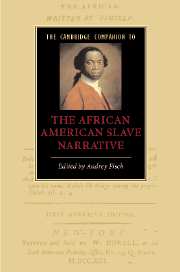Book contents
- Frontmatter
- Introduction
- Part I: The Slave Narrative and Transnational Abolitionism
- Part II: The Slave Narrative and Anglo-American Literary Traditions
- Part III: The Slave Narrative and the African American Literary Tradition
- Part IV: The Slave Narrative and the Politics of Knowledge
- 11 Harriet Jacobs: a case history of authentication
- 12 Frederick Douglass’s self-fashioning and the making of a Representative American man
- 13 Beyond Douglass and Jacobs
- 14 Black womanhood in North American women’s slave narratives
- Further Reading
- Index
12 - Frederick Douglass’s self-fashioning and the making of a Representative American man
from Part IV: - The Slave Narrative and the Politics of Knowledge
Published online by Cambridge University Press: 28 July 2007
- Frontmatter
- Introduction
- Part I: The Slave Narrative and Transnational Abolitionism
- Part II: The Slave Narrative and Anglo-American Literary Traditions
- Part III: The Slave Narrative and the African American Literary Tradition
- Part IV: The Slave Narrative and the Politics of Knowledge
- 11 Harriet Jacobs: a case history of authentication
- 12 Frederick Douglass’s self-fashioning and the making of a Representative American man
- 13 Beyond Douglass and Jacobs
- 14 Black womanhood in North American women’s slave narratives
- Further Reading
- Index
Summary
Frederick Douglass was the most famous African American of the nineteenth century and one of its greatest writers and intellectuals. Over the course of his long life from 1818 to 1895, he published three autobiographies, one novella, and a dozen or so speeches in pamphlet form. He delivered thousands of lectures and was one of America's best orators, at a time when public speaking was a major form of entertainment. For sixteen years, he edited, under three different names, the longest-running black newspaper in the nineteenth century. And thousands of photographs and engravings of him were in circulation, in forms that ranged from frontispiece engravings to daguerreotypes, ambrotypes, cartes de visite, and cabinet cards. He sat for his portrait at least as much as Walt Whitman, who was famous for visually creating and re-creating himself. As early as 1860, his “likeness” was familiar to virtually every American.
Douglass became an American icon through art. He brilliantly used the power of the word, voice, and image to write himself into public existence and remake himself while seeking to reform his nation. He was widely called “a Representative Man”: his close friend, the black abolitionist and physician James McCune Smith, referred to him as a “Representative American man” because he continually transformed himself; he “passed through every gradation of rank comprised in our national make-up and bears upon his person and his soul everything that is American.”
- Type
- Chapter
- Information
- The Cambridge Companion to the African American Slave Narrative , pp. 201 - 217Publisher: Cambridge University PressPrint publication year: 2007
- 5
- Cited by



